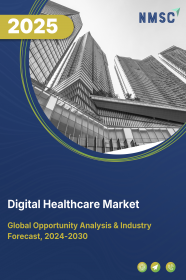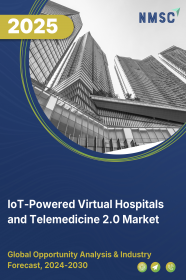
Digital Healthcare Market by Technology (Digital Health Systems, Tele-Healthcare, mHealth, and Healthcare Analytics), by Component (Software, Services, and Hardware), by Delivery Mode (On-Premise and Cloud-Based), by Application (Cardiology, Diabetes, Neurology, Sleep Apnea, Oncology, and Others), and by End User (Healthcare Providers, Healthcare Payers, Pharmaceutical Companies, and Others) – Global Opportunity Analysis and Industry Forecast 2023-2030
Market Definition:
The global Digital Healthcare Market size was valued at USD 240.19 billion in 2022 and is predicted to reach USD 1043.39 billion by 2030 with a CAGR of 23.3% from 2023-2030. Digital healthcare refers to the integration of information technology and electronic communications that are used for healthcare processes to manage illness & health risks as well as promote wellness to patient. This technology applies digital transformation to healthcare industry by integrating software, hardware and services.
Digital healthcare includes mobile health, wearable devices, health information technology (IT), telehealth & telemedicine and personalized medicine. Digital healthcare provides various services that enables consumers to early diagnosis of life-threatening diseases, treatment and management of chronic diseases. The digital access of healthcare tools also provides a comprehensive picture of patient health to healthcare professionals and improves medical outcomes and enhances efficiency.
Market Dynamics and Trends
Many governments and healthcare regulatory bodies are actively promoting the adoption of digital healthcare solutions such as telemedicine and telehealth services and Electronic Healthcare Records (EHR). They offer incentives, grants, and supportive policies to encourage healthcare providers and organizations to invest and implement digital health technologies, which in turn boosts the digital healthcare market growth. For instance, the World Health Organization (WHO) developed a global strategy on digital health 2020-2025 to promote the appropriate use of digital technologies for health and strengthen governance for digital health at global, regional, and national levels.
Also, the rising focus on enhanced patient care, efficient data management, and patient data security is boosting the adoption of Electronic Medical Record (EMR) and Electronic Health Record (EHR) that enables to maintain patients’ electronic health records, thus it is further propelling the growth of the digital healthcare market. Moreover, growing demand for telehealth services that offers Remote Patient Monitoring (RMP), and mobile health communication with patients is further driving the growth of market.
However, limited access to technology and lack of digital literacy among individuals, particularly in low-income countries, are the factors restraining the growth of market. On the contrary, the integration of data analytics and Artificial Intelligence (AI) in digital healthcare allows more precise diagnosis, personalized treatment plans, and predictive insights analyzing large datasets and identify patterns that can lead to better patient outcomes and improved population health management. Thus, it is expected to create ample growth opportunities for the digital healthcare market in the future.
Market Segmentations and Scope of the Study
The digital healthcare market share is segmented on the basis of technology, component, delivery mode, application, end user, and region. On the basis of technology, the market is divided into digital health systems, telehealthcare, mHealth, and healthcare analytics. Digital health systems are further sub-divided into EHR/EMR, e-prescribing systems.
Telehealthcare is further divided into activity monitoring, remote medication management, LTC monitoring, video consultation. mHealth is further divided into wearables and mHealth apps. Again, wearables are sub-segmented into glucose meters, neurological monitors, sleep apnea monitors, pulse oximeters, BP monitors, and others. Furthermore, mHealth apps is also segmented into fitness apps, medical apps.
On the basis of component, the market is classified into software, services, and hardware. On the basis of delivery mode, the market is categorized into on-premise and cloud-based. On the basis of application, the market is bifurcated into cardiology, diabetes, neurology, sleep apnea, oncology, and others.
On the basis of end user, the market is segmented into healthcare providers, healthcare payers, pharmaceutical companies, and others. Regional breakdown and analysis of each of the aforesaid segments includes regions comprising of North America, Europe, Asia-Pacific, and RoW.
Geographical Analysis
North America is the leading market for digital healthcare and is expected to maintain its dominance in the coming years. This is attributed to rising government initiatives to implement digital healthcare in this region. According to the United States Agency for International Development (USAID), the U.S. government initiated “A Vision for Action in Digital Health 2020-2024” program to promote the implementation of digital healthcare in the country, including establishing centers of excellence, investing in public health informatics and technology programs, and expanding access to telehealth services in rural areas. These initiatives aim to improve the availability and use of data in health systems and accelerate digital enablement of the global health workforce.
Also, presence of major key players such as Mckesson Corporation, Cerner Corporation, Cisco Systems, and Qualcomm technologies are adopting various collaborations that boosts the digital healthcare market growth in this region. For instance, in July 2021, Cerner Corporation collaborated with Baystate Health to advance digital health platform to integrate care delivery and financing solutions for consumer-focused approach to patient care. The digital innovation helped to improve patient access to personalized care, provides physicians with clearer insights into patient populations and uses data to drive more effective disease management and virtual healthcare experiences.
On the other hand, Asia-Pacific region is expected to show a steady rise in the digital healthcare market due to the growing implementation of digitization and various programs regarding digital healthcare in this region. For instance, in September 2021, the government of India launched the National Digital Health Mission. This mission was intended to create the foundation necessary to support the integrated digital health infrastructure of the country’s Pradhan Mantri Digital Health Mission (PM-DHM).
Also, in February 2021, the government of Japan launched health digitization program with Cisco to digitally transform the country’s healthcare sector. This project aims with a vision of Japan’s Society 5.0 that aims to stimulate Japan’s economic growth, enhance quality of life and create a society where an individual can fully reap the benefits of digital transformation.
Competitive Landscape
The digital healthcare industry comprises of various market players, such as Allscripts Healthcare Solution Inc., Cerner Corporation, Cisco Systems, Mckesson Corporation, Siemens Healthineers AG, Qualcomm technologies Inc., Koninklijke Philips N.V, AT&T, IBM Corporation, GE Healthcare, and others. These market players are adopting various strategies such as product launches, collaboration and expansion of business across various regions to maintain their dominance in the digital healthcare market.
For instance, in November 2022, McKesson Canada, launched new digital ecosystem aimed at simplifying and enhancing specialty patient care. The digital platform integrates innovative technologies to streamline healthcare processes, improve communication between healthcare providers and patients, and optimize treatment outcomes. This product launch reflects the growing trend of digital solutions in the healthcare industry, showcasing the potential of technology to transform patient care and contribute to the advancement of the digital healthcare market.
Also, in July 2021, Koninklijke Philips N.V, and Cognizant announced collaboration to introduce digital health solutions to providers, researchers, and patients. This strategic collaboration brings together Philips HealthSuite, a cloud-based platform and Cognizant’s digital engineering expertise to deploy and maintain leading-edge digital health solutions at scale, delivering advanced connectivity and using big data to generate actionable insights. In addition, in June 2021, Siemens Healthineers AG announced expansion of digital healthcare platform. It offered a new digital service offerings on Teamplay Digital Health Platform Connect healthcare platform.
Key Benefits
-
The report provides a quantitative analysis and estimations of the digital healthcare market from 2023 to 2030, which assists in identifying the prevailing market opportunities.
-
The study comprises a deep dive analysis of the digital healthcare industry, including the current and future trends to depict the prevalent investment pockets in the market.
-
Information related to key drivers, restraints, and opportunities and their impact on the digital healthcare industry, is provided in the report.
-
Competitive analysis of the players, along with their market share is provided in the report.
-
SWOT analysis and Porter's Five Forces model is elaborated on in the study.
-
Value chain analysis in the market study provides a clear picture of roles of stakeholders.
Digital Healthcare Market Key Segments
By Technology
-
Digital Health Systems
-
EHR/EMR
-
e-Prescribing Systems
-
-
Tele-Healthcare
-
Activity Monitoring
-
Remote Medication Management
-
Long-Term Care (LTC) Monitoring
-
Video Consultation
-
-
mHealth
-
Wearables
-
Glucose Meters
-
Neurological Monitors
-
Sleep Apnea Monitors
-
Pulse Oximeters
-
BP Monitors
-
Others
-
-
mHealth Apps
-
Fitness Apps
-
Medical Apps
-
-
-
Healthcare Analytics
By Component
-
Software
-
Services
-
Hardware
By Delivery Mode
-
On-Premise
-
Cloud-Based
By Application
-
Cardiology
-
Diabetes
-
Neurology
-
Sleep Apnea
-
Oncology
-
Others
By End User
-
Healthcare Providers
-
Healthcare Payers
-
Pharmaceutical Companies
-
Others
By Region
-
North America
-
US
-
Canada
-
Mexico
-
-
Europe
-
UK
-
Germany
-
France
-
Italy
-
Spain
-
Denmark
-
Netherlands
-
Finland
-
Sweden
-
Norway
-
Russia
-
Rest of Europe
-
-
Asia-Pacific
-
China
-
Japan
-
India
-
South Korea
-
Australia
-
Indonesia
-
Singapore
-
Taiwan
-
Thailand
-
Rest of Asia-Pacific
-
-
RoW
-
Latin America
-
Middle East
-
Africa
-
Key Players
-
Allscripts Healthcare Solution Inc.
-
Cerner Corporation
-
Cisco Systems
-
Mckesson Corporation
-
Siemens Healthineers AG
-
Qualcomm technologies Inc.
-
Koninklijke Philips N.V
-
AT&T
-
IBM Corporation
-
GE Healthcare
REPORT SCOPE AND SEGMENTATION:
|
Parameters |
Details |
|
Market Size in 2022 |
USD 240.19 Billion |
|
Revenue Forecast in 2030 |
USD 1043.39 Billion |
|
Growth Rate |
CAGR of 23.3% from 2023 to 2030 |
|
Analysis Period |
2022–2030 |
|
Base Year Considered |
2022 |
|
Forecast Period |
2023–2030 |
|
Market Size Estimation |
Billion (USD) |
|
Growth Factors |
Growing emphasis on improved patient care, streamlined data management, and heightened patient data security. Governments and healthcare regulatory bodies promoting the adoption of digital healthcare solutions such as telemedicine and telehealth services and others. |
|
Countries Covered |
28 |
|
Companies Profiled |
10 |
|
Market Share |
Available for 10 companies |
|
Customization Scope |
Free customization (equivalent up to 80 working hours of analysts) after purchase. Addition or alteration to country, regional, and segment scope. |
|
Pricing and Purchase Options |
Avail customized purchase options to meet your exact research needs. |




















 Speak to Our Analyst
Speak to Our Analyst

























